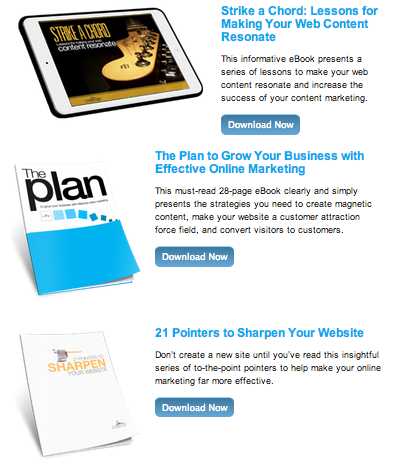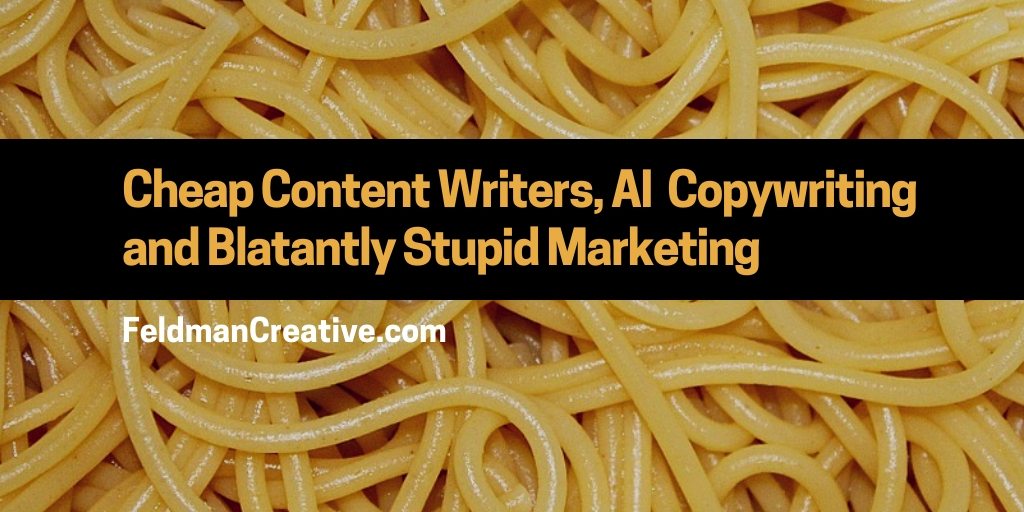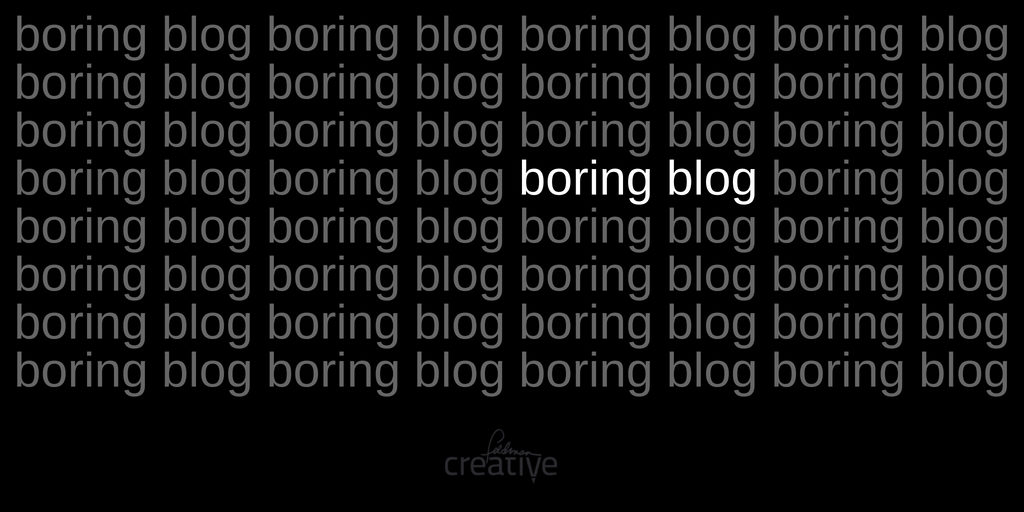 Powerful headlines can simply be tantalizing teasers.
Powerful headlines can simply be tantalizing teasers.
From the point of view of a marketing writer of 25 years (yeah, that’d be me), a headline has one objective: inspire the reader to read the next line.
This applies to your email’s subject line or your blog post title in the biggest way. It applies to social media because it’s your headline that will most likely be shared and clicked—or not.
So Which Headline Writing Technique Works Best?
Marketing geniuses always yack on about how important it is to get right to the point. Old school ad guys Ogilvy, Bernbach and Burnett seem to have cemented a rule stating a user benefit goes in the headline.
They’d tell you the headline is often the only line people read. Get right to the point, they’d insist. Don’t bury the lead… and blahbiddy blah.
As much as I admire these pioneers, I think this advice is crap.
Verbal Foreplay Is More My Style.
Perhaps you’ve noticed. I didn’t subscribe to the benefits-first formula in this article and I seldom do with the many things I write.
I believe when the goal is to get people to tune in, the tact to take is to turn on their curiosity. But it’s not like I’ve tapped into some breakthrough new discovery in psychology and human behavior. I’m simply saying a little dose of suspense or even an anxiety inducer makes for the ultimate attention-getter.
You Have To Choose Your Words Carefully.
And if you buy into this technique, which I’ve labeled “perfect,” you’ll understand the perfect headline is a teaser. A hint. You hold out on the big idea. You work up to it.
You pose a question. Why? Good question.
It drives you crazy not to know the answer, doesn’t it? You may even get more worked up when you don’t entirely understand the question. Or the question is the answer. Or the answer is a question.
I’m messing with you a little. It’s working like a charm too. I keep stringing you along and you’re hanging in there.
I love that about you. You’re curious. Your customers are curious. I’m curious. Everyone is. So choosing your words is also about choosing which ones to leave out.
Bring On Some Psychology

Wouldn’t my premise be even more perfect if it was verified by a little science? I thought so and decided to tap the mind of online marketer and blogger extraordinaire, Gregory Ciotti. You know his work from contributions he makes here at the Unbounce blog.
Gregory is an expert on behavioral psychology and seems to always have a study on the science of persuasion in his back pocket. So it wasn’t surprising when Gregory recognized the approach and cited “The Information Gap Theory,” made famous by George Loewenstein, a leader in the fields of behavioral economics and neuroeconomics.
“This is one of the better research papers in my opinion that relate to marketing,” said Ciotti. “The theory claims when you spark an interest or desire that is already there—which means topicality is important— you tickle that interest and the reader attempts to close the gap by finding out the answer.”
Another explanation I found comes from a Wired.com article, “The Itch of Curiosity,” by Johan Lehrer, who writes, “According to Loewenstein, curiosity is rather simple: It comes when we feel a gap between what we know and what we want to know. This gap has emotional consequences: it feels like a mental itch, a mosquito bite on the brain. We seek out new knowledge because we that’s how we scratch the itch.”
The Nagging Effect of Dissonance
In my interview with Ciotti, he also cited the “Zeigarnik Effect,” which essentially speaks to a human desire to finish what we start. When a task is unfinished, we experience dissonance. (More on this here.)
Gregory explained, “When you give people brain buster puzzles and stuff like that and then interrupt them and tell them they must stop now, experiments have proved up 90% of the people go back to finish the test. We really do feel discomfort when we don’t know the answer to something we want to know.”
But Nothing’s Perfectly Perfect
“The problem with headlines that aim to pique curiosity is they can go wrong if the desire isn’t already there,” Gregory said. “If you do happen to ask the right question and spark an interest on a topic readers are already passionate about and ask a question they really, really want to know the answer to, then you can use that mystique to get people to pay attention.”
Did it work here?
Your curiosity got you here. So it worked on you. Those not interested in closing an information gap on writing the perfect headline are probably off scratching some other itch.
What if I wrote this?
The Perfect Headline Arouses Your Curiosity
Not bad, I guess, but you’d have gathered the gist of the article before you read it.
How about this?
Use The Information Gap Theory to Write The Perfect Headline
Risky, right? You may not be curious enough to read on if you never heard of the theory.
I’m good with the headline I wrote. It sucked you in. It itched your brain. I hope I was able to scratch it.
[This post was originally written for the Unbounce blog.]
GET FREE eBOOKS to make your online marketing more effective HERE.



![How to Write Powerful Headlines for Your Online Content [Infographic] How to Write Powerful Headlines for Your Online Content [Infographic]](https://feldmancreative.com/wp-content/uploads/2019/04/Screen-Shot-2019-04-19-at-5.38.54-PM.png)
![Business Blogging Trends – 4th Annual Survey [Content Jam Episode 36] Business Blogging Trends – 4th Annual Survey [Content Jam Episode 36]](https://feldmancreative.com/wp-content/uploads/2018/10/Content-Jam-podcast-36.jpg)


Comments
Copywriting 101: The Principles of Irresistible Content |
[…] A curiosity builder: This tactic has a teaser element that capitalizes on suspense and mystery. (Read “How Do You Write the Powerful Headlines?”) […]
Copywriting 101: The Principles of Irresistible Content | Words In Verses™
[…] A curiosity builder: This tactic has a teaser element that capitalizes on suspense and mystery. (Read “How Do You Write the Powerful Headlines?”) […]
Cranberry Sauce, Content Marketing and Giving Thanks | Feldman Creative
[…] How Do You Write Powerful Headlines? […]
Cranberry Sauce, Content Marketing and Giving Thanks [SLIDESHARE]
[…] Gregory Ciotti, Jason Falls, Doug Kessler, Megan Berry, Spencer Haws (on a Convince and Convert article) […]
Cranberry Sauce, Content Marketing and Giving Thanks [SLIDESHARE] | Instant Free Commissions
[…] Gregory Ciotti, Jason Falls, Doug Kessler, Megan Berry, Spencer Haws (on a Convince and Convert article) […]
Jerod Morris
Barry, thank you for providing the scientific backing for why question headlines work so well. Makes great sense … and who is going to argue with Greg Ciotti? 😉
I think you maybe, perhaps, possibly go a tad overboard in saying that the advice of Ogilvy, et al, regarding promising a benefit in a headline is “crap” … but your point is well taken that a headline needs to do more than JUST that, it needs to pique curiosity, to be maximally effective — which is simply to get as many of the right people as possible to click and read your first line.
Barry Feldman
Thanks Jerod. I’ll give you Ogilvy obviously was not full of crap. However, he often presented his tips as the gospel such as claiming you should always do this or never do that. And of course, times have changed. Subscribing to his headline writing advice today — the tip that says ALWAYS put your benefit in the heads — isn’t valid.
And yeah, Ciotti certainly knows what he’s talking about.